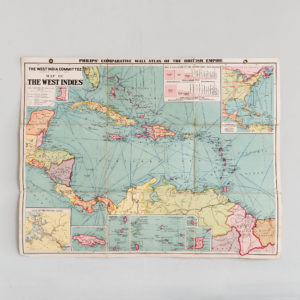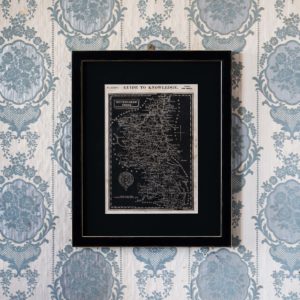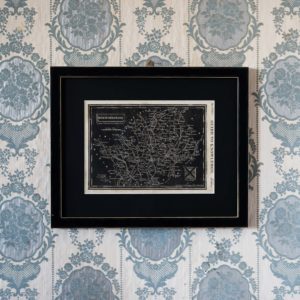No products in the basket.
18 items found
Page 1 of 1
-

Cary’s New Plan of London and it’s Vicinity 1838
£1,400Cary’s New Plan of London and it’s Vicinity 1838
Detailed map with original hand-colour showing the limits of the two penny postal delivery service. Framed£1,400 -

Philips’ A Map of Europe To Illustrate The Territorial Changes Since 1914
£1,200Philips’ A Map of Europe To Illustrate The Territorial Changes Since 1914
The Royal Geographical Society was founded in 1830 as an institution to promote the 'advancement of geographical science'.£1,200 -

A General Prospect of Vaux Hall Gardens. Shewing at one View the disposition of the whole Gardens. Vüe Détaillee des Jardins de Vaux Hall.
£850A General Prospect of Vaux Hall Gardens. Shewing at one View the disposition of the whole Gardens. Vüe Détaillee des Jardins de Vaux Hall.
Originally engraved by William Simpkins (fl.1784-1825) for Owen Manning and William Bray’s “History and Antiquities of Surrey” (1804-1814).£850 -

Plan of Vauxhall Gardens
£220Plan of Vauxhall Gardens
Originally engraved by William Simpkins (fl.1784-1825) for Owen Manning and William Bray’s “History and Antiquities of Surrey” (1804-1814).£220 -

Philips’ The West India Committee map of The West Indies
£120 -

Pinnock’s Knowledge 1838,
£120 eachPinnock’s Knowledge 1838,
Woodblock print published 1838.William Pinnock, born 1782 was an, English publisher and educational writer. In 1817 he went to London and, in partnership with Samuel Mander, began to publish cheap educational works. The firm's first productions were a series of Catholic instructional works aimed at the young, arranged in the form of question and answer, of the different departments of knowledge. They were followed by abridged editions of Goldsmith's histories of England, Greece and Rome, and a series of county histories which were no less profitable. Pinnock lost nearly all his money in outside speculation, and died in London on the 21st of October 1843.
£120 each -

Pinnock’s Knowledge 1838,
£120 eachPinnock’s Knowledge 1838,
Woodblock print published 1838.William Pinnock, born 1782 was an, English publisher and educational writer. In 1817 he went to London and, in partnership with Samuel Mander, began to publish cheap educational works. The firm's first productions were a series of Catholic instructional works aimed at the young, arranged in the form of question and answer, of the different departments of knowledge. They were followed by abridged editions of Goldsmith's histories of England, Greece and Rome, and a series of county histories which were no less profitable. Pinnock lost nearly all his money in outside speculation, and died in London on the 21st of October 1843.
£120 each -

Pinnock’s Knowledge 1838,
£120 eachPinnock’s Knowledge 1838,
Woodblock print published 1838.William Pinnock, born 1782 was an, English publisher and educational writer. In 1817 he went to London and, in partnership with Samuel Mander, began to publish cheap educational works. The firm's first productions were a series of Catholic instructional works aimed at the young, arranged in the form of question and answer, of the different departments of knowledge. They were followed by abridged editions of Goldsmith's histories of England, Greece and Rome, and a series of county histories which were no less profitable. Pinnock lost nearly all his money in outside speculation, and died in London on the 21st of October 1843.
£120 each -

Pinnock’s Knowledge 1838,
£120 eachPinnock’s Knowledge 1838,
Woodblock print published 1838.William Pinnock, born 1782 was an, English publisher and educational writer. In 1817 he went to London and, in partnership with Samuel Mander, began to publish cheap educational works. The firm's first productions were a series of Catholic instructional works aimed at the young, arranged in the form of question and answer, of the different departments of knowledge. They were followed by abridged editions of Goldsmith's histories of England, Greece and Rome, and a series of county histories which were no less profitable. Pinnock lost nearly all his money in outside speculation, and died in London on the 21st of October 1843.
£120 each -

Pinnock’s Knowledge 1838,
£120 eachPinnock’s Knowledge 1838,
Woodblock print published 1838.William Pinnock, born 1782 was an, English publisher and educational writer. In 1817 he went to London and, in partnership with Samuel Mander, began to publish cheap educational works. The firm's first productions were a series of Catholic instructional works aimed at the young, arranged in the form of question and answer, of the different departments of knowledge. They were followed by abridged editions of Goldsmith's histories of England, Greece and Rome, and a series of county histories which were no less profitable. Pinnock lost nearly all his money in outside speculation, and died in London on the 21st of October 1843.
£120 each -

Pinnock’s Knowledge 1838,
£120 eachPinnock’s Knowledge 1838,
Woodblock print published 1838.William Pinnock, born 1782 was an, English publisher and educational writer. In 1817 he went to London and, in partnership with Samuel Mander, began to publish cheap educational works. The firm's first productions were a series of Catholic instructional works aimed at the young, arranged in the form of question and answer, of the different departments of knowledge. They were followed by abridged editions of Goldsmith's histories of England, Greece and Rome, and a series of county histories which were no less profitable. Pinnock lost nearly all his money in outside speculation, and died in London on the 21st of October 1843.
£120 each -

Pinnock’s Knowledge 1838,
£120 eachPinnock’s Knowledge 1838,
Woodblock print published 1838.William Pinnock, born 1782 was an, English publisher and educational writer. In 1817 he went to London and, in partnership with Samuel Mander, began to publish cheap educational works. The firm's first productions were a series of Catholic instructional works aimed at the young, arranged in the form of question and answer, of the different departments of knowledge. They were followed by abridged editions of Goldsmith's histories of England, Greece and Rome, and a series of county histories which were no less profitable. Pinnock lost nearly all his money in outside speculation, and died in London on the 21st of October 1843.
£120 each -

Pinnock’s Knowledge 1838,
£120 eachPinnock’s Knowledge 1838,
Woodblock print published 1838.William Pinnock, born 1782 was an, English publisher and educational writer. In 1817 he went to London and, in partnership with Samuel Mander, began to publish cheap educational works. The firm's first productions were a series of Catholic instructional works aimed at the young, arranged in the form of question and answer, of the different departments of knowledge. They were followed by abridged editions of Goldsmith's histories of England, Greece and Rome, and a series of county histories which were no less profitable. Pinnock lost nearly all his money in outside speculation, and died in London on the 21st of October 1843.
£120 each -

Pinnock’s Knowledge 1838,
£120 eachPinnock’s Knowledge 1838,
Woodblock print published 1838.William Pinnock, born 1782 was an, English publisher and educational writer. In 1817 he went to London and, in partnership with Samuel Mander, began to publish cheap educational works. The firm's first productions were a series of Catholic instructional works aimed at the young, arranged in the form of question and answer, of the different departments of knowledge. They were followed by abridged editions of Goldsmith's histories of England, Greece and Rome, and a series of county histories which were no less profitable. Pinnock lost nearly all his money in outside speculation, and died in London on the 21st of October 1843.
£120 each -

Pinnock’s Knowledge 1838,
£120 eachPinnock’s Knowledge 1838,
Woodblock print published 1838.William Pinnock, born 1782 was an, English publisher and educational writer. In 1817 he went to London and, in partnership with Samuel Mander, began to publish cheap educational works. The firm's first productions were a series of Catholic instructional works aimed at the young, arranged in the form of question and answer, of the different departments of knowledge. They were followed by abridged editions of Goldsmith's histories of England, Greece and Rome, and a series of county histories which were no less profitable. Pinnock lost nearly all his money in outside speculation, and died in London on the 21st of October 1843.
£120 each -

Pinnock’s Knowledge 1838
£120 eachPinnock’s Knowledge 1838
Woodblock print published 1838.William Pinnock, born 1782 was an, English publisher and educational writer. In 1817 he went to London and, in partnership with Samuel Mander, began to publish cheap educational works. The firm's first productions were a series of Catholic instructional works aimed at the young, arranged in the form of question and answer, of the different departments of knowledge. They were followed by abridged editions of Goldsmith's histories of England, Greece and Rome, and a series of county histories which were no less profitable. Pinnock lost nearly all his money in outside speculation, and died in London on the 21st of October 1843.
£120 each -

Pinnock’s Knowledge 1838
£120 eachPinnock’s Knowledge 1838
Woodblock print published 1838.William Pinnock, born 1782 was an, English publisher and educational writer. In 1817 he went to London and, in partnership with Samuel Mander, began to publish cheap educational works. The firm's first productions were a series of Catholic instructional works aimed at the young, arranged in the form of question and answer, of the different departments of knowledge. They were followed by abridged editions of Goldsmith's histories of England, Greece and Rome, and a series of county histories which were no less profitable. Pinnock lost nearly all his money in outside speculation, and died in London on the 21st of October 1843.
£120 each -

Pinnock’s Knowledge 1838
£120 eachPinnock’s Knowledge 1838
Woodblock print published 1838.William Pinnock, born 1782 was an, English publisher and educational writer. In 1817 he went to London and, in partnership with Samuel Mander, began to publish cheap educational works. The firm's first productions were a series of Catholic instructional works aimed at the young, arranged in the form of question and answer, of the different departments of knowledge. They were followed by abridged editions of Goldsmith's histories of England, Greece and Rome, and a series of county histories which were no less profitable. Pinnock lost nearly all his money in outside speculation, and died in London on the 21st of October 1843.
£120 each
Featured Items
-

Henri Matisse, ‘The Last Works of Henri Matisse’
£900 eachHenri Matisse, ‘The Last Works of Henri Matisse’
From Verve Vol. IX No. 35/36 published by Tériade under the title 'The Last Works of Henri Matisse'£900 each -

18th Century French Engravings of Dogs
£175 each18th Century French Engravings of Dogs
Published for, Histoire naturelle, générale et particulière (1749–1804), which was the first modern attempt to systematically present all existing knowledge in the fields of natural history, geology, and anthropology.£175 each -

Printemps by Marc Chagall, Verve Vol. 1 / No. 3.
£800Printemps by Marc Chagall, Verve Vol. 1 / No. 3.
The Verve Review was a purposefully luxurious. It ran from 1937 to 1960, but with only 38 editions available, due to the high degree of design and editorial work dedicated to each issue. Each edition contained unique lithographic prints, commissioned by the editor, and each cover a double-page lithograph elaborated by one of the artists contained within. It was the brainchild of its editor Stratis Eleftheriades, a Greek National who moved to Paris in the early thirties to take part in the growing Modernist movement, writing under the name of Teriade.£800 -

Comets by Wassily Kandinsky, Verve Vol. 1 / No. 2.
£800Comets by Wassily Kandinsky, Verve Vol. 1 / No. 2.
The Verve Review was a purposefully luxurious. It ran from 1937 to 1960, but with only 38 editions available, due to the high degree of design and editorial work dedicated to each issue. Each edition contained unique lithographic prints, commissioned by the editor, and each cover a double-page lithograph elaborated by one of the artists contained within. It was the brainchild of its editor Stratis Eleftheriades, a Greek National who moved to Paris in the early thirties to take part in the growing Modernist movement, writing under the name of Teriade.£800
